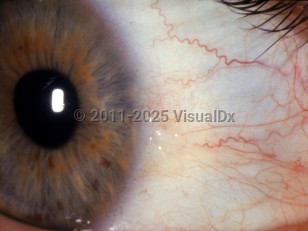Pinguecula - External and Internal Eye
Alerts and Notices
Important News & Links
Synopsis

A pinguecula is a yellowish, slightly raised, lipid-like deposit in the interpalpebral nasal and temporal limbal conjunctiva. Unlike pterygiums, pingueculae have a space between them and the edge of the cornea. However, they can develop into pterygiums. And like pterygiums, pingueculae can become vascularized, inflamed, and produce punctate staining of the corneal epithelium as well as form corneal dellen. They are frequently bilateral, do not have a sexual or racial predilection, but are seen most often in people who are chronically exposed to the sun. Patients present with either just the finding of the growth or, when inflamed, patients complain of irritation, redness, blurring of vision, itching, difficulty wearing contact lenses, and foreign body feeling. Environmental factors such as wind, dust, noxious chemicals, dirt, air pollution, and allergens can cause inflammation and, if chronic, can lead to pterygium transformation.
Codes
ICD10CM:
H11.159 – Pinguecula, unspecified eye
SNOMEDCT:
87614000 – Pinguecula
H11.159 – Pinguecula, unspecified eye
SNOMEDCT:
87614000 – Pinguecula
Look For
Subscription Required
Diagnostic Pearls
Subscription Required
Differential Diagnosis & Pitfalls

To perform a comparison, select diagnoses from the classic differential
Subscription Required
Best Tests
Subscription Required
Management Pearls
Subscription Required
Therapy
Subscription Required
References
Subscription Required
Last Updated:03/10/2015

